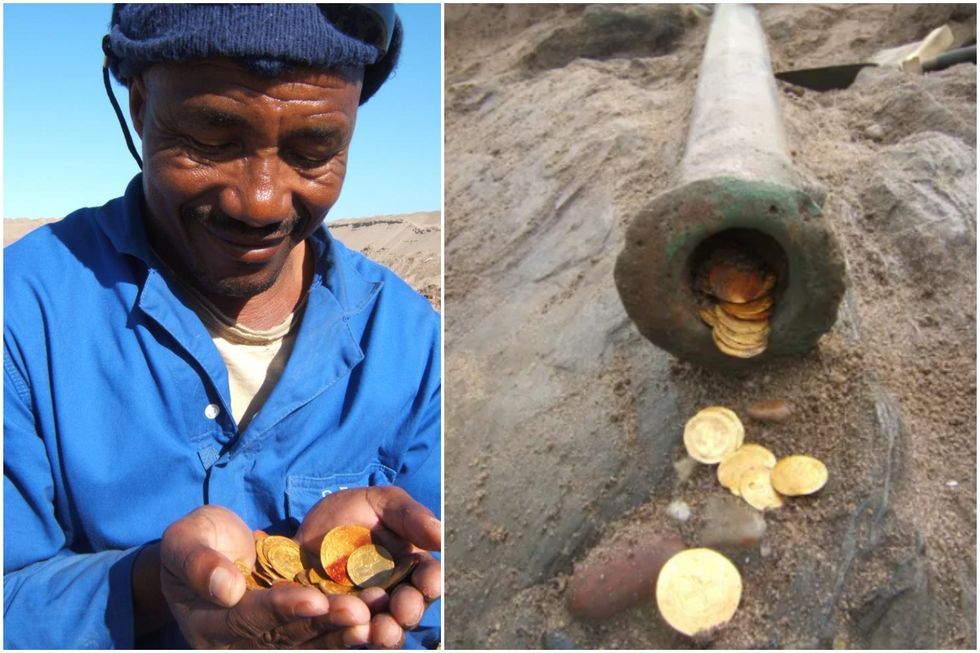Harriet Brewis
Jul 17, 2024
The mission to recover bounty of 'ncalculable value' from legendary Caribbean shipwreck
FMM - F24 Video Clips / VideoElephant
One of the most significant shipwreck finds of recent times was made in an ostensibly unlikely place: a southwest African desert.
The Bom Jesus (The Good Jesus), a Portuguese ship, set sail for India from Lisbon on 7 March, 1533, when it got caught up in a devastating storm.
The vessel, which was laden with treasures, seemed to disappear without a trace until, in 2008, its remains were finally discovered along with around $13 million-worth of gold coins.
It was unearthed by diamond miners in a desert on the coast of Namibia, who had drained a man-made lagoon in the area.
Dr Dieter Noli, chief archeologist of the Southern Africa Institute of Maritime Archaeological Research, said he had expected miners to one day come across a shipwreck.
Indeed, the Namibian miners, who worked for the diamond company De Beers, called Dr Noli as soon as they made the find, since he had been telling them for more than a decade what to look for.
"Having first started doing archaeological work [...] for the mine in 1996, I had at that point been preaching to them for a dozen years that ‘one day’ they would find a shipwreck, and to let me know when they do,” he told Fox News back in 2016.
“When asked what exactly I was really expecting to find, I said ‘a Spanish sword and a bag of gold.’”

Nevertheless, it wasn’t until almost a week into the excavation of the ship that a treasure chest packed with gold was found.
“As luck would have it, we found the treasure chest on day six,” Dr Noli recounted.
“Academic arguments are all very well, but once you have literally filled your hat with a 25.5lb mixture of Spanish and Portuguese gold coins (there were indeed swords as well), the value of the site is no longer in doubt.”
It was at this point that the ship was confidently identified as the Bom Jesus, which records showed had been loaded with tin, ivory tusks, and 44,000 pounds of copper ingots, as well as gold.
In fact, the copper ingots ended up playing a key role in the wreck’s preservation since, according to Dr Noli: “Marine organisms may like wood, leather book covers, peach pips, jute sacking and leather shoes, but copper really puts them off their food – so a lot of stuff survived the 500 years on the bottom of the sea which should really not have done so.
“All this adds up to an extremely unusual situation, which led to truly excellent preservation of an in any event unique site.”
In total, the excavation of the ship yielded tousands of Portuguese and Spanish gold coins, Portuguese silver coins, bronze cannons, tonnes of copper ingots, more than 50 elephant tusks, navigational instruments, cooking utensils, and swords and muskets.
Dr Noli told news.co.au that more than 2,000 gold coins were uncovered, as well as five anchors, three navigational dividers and part of a ship’s compass. But only a small part of the ship's original structure remained, having been “extremely badly battered” by the sea.

It remains unclear exactly how the ship went down and why it ended up on a stretch of coastline notorious for its fierce storms and dense fog.
However, experts believe that the Bom Jesus sank when it was pulled too close to shore by an especially violent storm, causing its hull to collide with a rock, capsizing the vessel, the Portuguese Ministry of Foreign Affairs wrote in a 2011 report.
As the coastline waters receded over the subsequent centuries, the ship later re-emerged in the desert.
Sadly for DeBeers and its team of miners, the company didn’t enjoy the spoils of their discovery.
“The Namibian government [got] every single coin,” Dr Noli confirmed to Fox News.
“That is the normal procedure when a ship is found on a beach. The only exception is when it is a ship of state – then the country under whose flag the ship was sailing gets it and all its contents.
“And in this case the ship belonged to the King of Portugal, making it a ship of state – with the ship and its entire contents belonging to Portugal. The Portuguese government, however, very generously waived that right, allowing Namibia to keep the lot.”
Now, more than 15 years since the historic find was made, the Bom Jesus remains the oldest and most valuable shipwreck ever discovered in Sub-Saharan Africa.
Sign up for our free Indy100 weekly newsletter
How to join the indy100's free WhatsApp channel
Have your say in our news democracy. Click the upvote icon at the top of the page to help raise this article through the indy100 rankings
Top 100
The Conversation (0)
x














